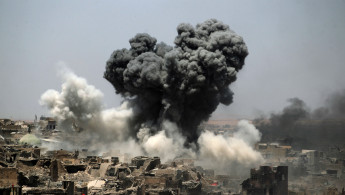Civilian deaths from airstrikes double in 2017, driven by Iraq and Syria casualties
The sharp rise in civilian deaths is largely due to a massive increase in the use of airstrikes by state actors such as the US, UK, Russia and Saudi Arabia in Syria, Iraq, and Yemen, according to figures compiled by Action on Armed Violence (AOAV).
Civilian deaths from airstrikes increased 82 percent from 2016, and 1,169 percent from 2011, when AOAV first started recording statistics.
The worst affected countries were Syria, where civilian deaths increased by 55 percent to 8,051, and Iraq, where there was a 50 percent increase, to 3,271.
The huge increase in airstrikes and civilian casualties in both countries was driven by US-led military operations to defeat the Islamic State group, with devastating military offensives utilising explosive weaponry to recapture Mosul in Iraq and Raqqa in Syria.
"States don't have the stomach to have troops on the ground and instead use warfare at a distance with airstrikes and missiles," Iain Overton, Director of Action on Armed Violence, told The New Arab.
 |
The number of civilians killed by states indicate that they are using explosive weaponry without a real consideration of proportionality or even ultimately civilian safety. -Iain Overton |
 |
"However, they are using these weapons in populated areas and despite claims that they are precision guided bombs they have clearly killed a disproportionate number of civilians in an attempt to fight terror".
The estimated number of civilian deaths as a result of US-led military operations against IS in Syria and Iraq was between 11,000 and 18,000, according to Airwars.
More than 9,000 civilians were killed in the campaign to recapture Mosul from IS according to an Associated Press report, a civilian casualty rate nearly 10 times higher than what had been previously reported.
When explosive weapons were used in populated areas around 92 percent of deaths and injuries were civilians, AOAV said.
Despite this, around 70 percent of incidents of explosive weaponry used by state actors took place in populated areas.
"The number of civilians killed by states indicate that they are using explosive weaponry without a real consideration of proportionality or even ultimately civilian safety", Overton said.
Twitter Post
|
War on terror a 'failure'
The steady rise of civilians killed by non-state actors using suicide bombings and Improvised Explosive Devices (IED) has in turn caused state actors to respond aggressively in conflict arenas, exemplified by the US dropping its largest non-nuclear bomb on Afghanistan in April 2017.
But Overton says that by using massive air warfare in the fight against terrorism the West and other governments are using a form of terror themselves.
"Throughout history there has never been a time when foreign powers have been unable to suppress an insurgency just by using air power," he told TNA.
"The war on terror is indicative of a constant failure in the Middle East and beyond and the fact so many civilians are still being killed by terrorism suggests the way the war on terror is being waged is not working".
According to AOAV statistics the number of civilians killed by terrorist explosive attacks in 2017 is the same as 2016, indicating a failed strategy.
Moreover, there has been a massive spread in terrorist activities outside of areas of direct military contact.
 |
The war on terror is indicative of a constant failure in the Middle East and beyond. |  |
In Somalia, for example, civilian deaths increased by 200 percent in 2017, with the worst terrorist attack in the country's history killing more than 512 people in Mogadishu.
The huge rise in civilian deaths also creates grievances which can be exploited by terrorist groups in their recruitment efforts.
"Violence begets violence, so it is not unreasonable to think that more civilians killed by government airstrikes will lead to more people to become radicalised in the face of such terror," Overton says.
'Lack of accountability'
While the US military has revealed that it has unintentionally killed at least 801 civilians in Syria and Iraq, the UK still says it has no credible evidence that its' airstrikes have resulted in civilian fatalities.
"Our data strongly points to the fact that it would almost impossible to have this many airstrikes in areas of civilian populations without civilians being killed," Overton says.
The Ministry of Defence has a policy of not recording civilian deaths, yet simultaneously claims not to have caused any fatalities.
The Royal Air Force (RAF), meanwhile, is using US principles in framing the distinction between combatants and non-combatants, Overton says, which is generally any male of fighting age.
With journalists often unable to embed in dangerous conflict zones and a marked decline in foreign correspondents, it is hard to properly scrutinise government claims about civilian death tolls, or who is a combatant or non-combatant.
"What this means is that we have probably underreported civilian deaths," Overton says.



